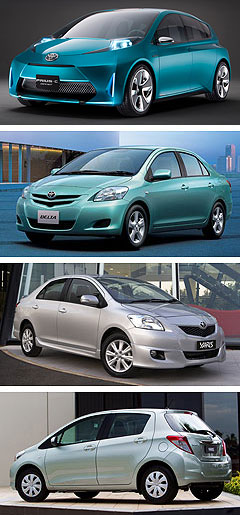Toyota Yaris hybrid, diesel not on Oz agenda
BY BYRON MATHIOUDAKIS | 26th Oct 2011

Due in the second quarter of 2012, the Prius C will slot beneath the established ‘full-sized’ Prius, which is also set to receive a facelift at the same time.
As GoAuto has reported, the Prius+ and related Prius V wagon variants are also under consideration for release in Australia next year.
The Yaris Hybrid, meanwhile, is due to launch in Europe soon, following its debut as the near-production Yaris HSD concept at the Geneva motor show in March.
Toyota Australia’s decision to overlook the Yaris Hybrid comes despite its sub-85g/km CO2 emissions rating, which would make the B-segment hatch the best in its field right now, beating the new standard-setting Kia Rio 1.1-litre three-cylinder turbo-diesel in Europe.
According to Yaris chief engineer Hirofumi Yamamoto, who was responsible for the new 130-series Yaris including the hybrid version, the petrol-electric Yaris is primarily a European model charged with helping reduce Toyota’s average corporate CO2 emissions.
A Toyota spokesman also told GoAuto at the new-generation Yaris launch in Melbourne this week that the company had “elected to focus on another smaller hybrid for Australia” – that is, the Prius C.
Full technical details are still to be divulged, but the Prius C is said to eclipse the 3.9L/100km performance of the standard Prius, while also bettering the Prius’ CO2 emissions rating of 89g/km.

Both the Yaris and Prius C hybrids share similar front-end structures, according to Mr Yamamoto, as well as various other drivetrain components in order to help keep costs down.
Furthermore, the European-market Yaris D-4D Diesel, available with a 1.4-litre four-cylinder turbo-diesel and six-speed manual combination returning 104g/km of CO2, has been ruled out for Australia due to its lack of a suitable automatic gearbox.
Pointing to the tiny light-car diesel market in Australia, coupled with the relatively cheap fuel price situation, Toyota has elected to stick with the petrol-only Yaris for the time being.
Meanwhile, the fate of the Yaris sedan remains unclear, following Toyota’s confirmation that it will not develop a three-box version of the new XP130 series.
As GoAuto has reported, Toyota Australia is investigating a four-door Yaris replacement in the form of a number of models, including the Etios sedan currently built in India.
However, one insider also this week suggested that Toyota is working on a replacement for the current XP90-based Yaris sedan (or Belta, as it is known overseas), featuring the 130 architecture with unique sheetmetal and cabin configuration.
Launched here in 2006, the Yaris sedan – which continues alongside the redesigned hatch – attracts around 15 per cent of total Yaris volume in Australia.
A spokesman said that the company would jump at the chance to import a new Yaris sedan into Australia.
“Toyota would not willingly give up that percentage of a segment,” he said.